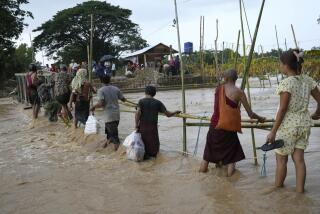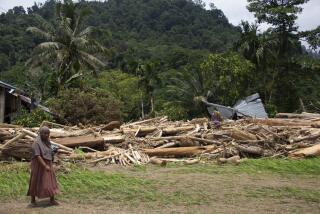Southeast Asia Is Parched by Drought
- Share via
CANDABA, Philippines — This is the year the rains didn’t come to Southeast Asia. Sun and heat conquered the land, and the paddies dried up, turned into a great expanse of cracked rust-red earth that yielded little but brown tufts of dying rice.
“These fields you see,” said Bienvenido Gatus, Candaba’s mayor, his hand sweeping toward the horizon, “should be under 5 feet of water this time of year. Normally, we couldn’t have even driven out here on this road. It’d be flooded too.”
But the thirsty land around him was as lifeless as a desert. The irrigation channels between the patchwork of abandoned paddies were stone dry and weed-clogged. There were no farmers about, even though in Candaba, two hours north of Manila by car, almost everyone is a farmer. The temperature stood at 100, and it was not yet noon.
The drought, now entering its second year, has already caused $20 billion in damages and lost crops in the region, the Asian Development Bank says. It has led to food shortages and several hundred deaths and is, environmentalists say, the most severe dry spell to strike Southeast Asia in at least 40 years.
Although rains in Vietnam, Indonesia and parts of the Philippines late last month lessened the crisis, meteorologists are not yet ready to declare the death of El Nino, the mysterious weather phenomenon that warms Pacific Ocean waters and leads to nasty climatic extremes. Rainfall remains well below normal and patchy in its pattern of delivery.
“This is the worst drought by far I’ve seen,” said Federico David, 52, who, with his wife, Zenaida, turned his five-acre rice farm into a garden for “swamp cabbage,” a poor man’s version of spinach. At least, he said, “with cabbage we won’t starve.”
The Davids tried to recoup their losses by raising fish in a pool they dug. But the water got so hot that the fish died. Their ducks were washed away in a flash flood in August.
What they still have--and what they pamper with shaded living quarters and ample food--are two water buffaloes. The beasts are the Davids’ greatest asset, and, when the rains return, they can help the family reclaim its old life as rice farmers.
Until the skies open anew, though, Southeast Asia will continue to tally the toll of a terrible 12 months--a period that Singaporean Information Minister George Yeo Yong Boon says has presented the region with its biggest calamity of the ‘90s.
First, there was the Asian economic crisis, which destroyed a decade of progress. Then, bush fires in Indonesia choked the region with heavy blankets of haze, causing economic losses estimated at $1.3 billion. And finally, the drought took hold of the land and ravaged the livelihoods of millions.
In varying degrees, the three nightmares are interrelated.
Though El Nino is blamed for the latest crisis, humans share the responsibility, environmentalists say. In the rush to develop their economies, governments let timber companies log and clear-cut forests. That left forests, rivers and lakes vulnerable to the effects of fire and drought.
“We cannot go on saying we want to be a developed country when we cannot handle basic needs such as protecting the environment,” said Gurmit Singh, an advisor to Malaysia’s Environmental Protection Society. He points out that economic development was accompanied by little consideration for expanding water and electricity supplies or safeguarding resources.
The economic crisis, in which currencies were devalued and stock markets plunged, forced millions of Asians who had moved to the cities in search of employment to return to their rural homes. But once there, they found that the drought had killed their chance to farm, for the current harvest season at least. And the drought fueled inflation by pushing up food prices, which, in turn, worsened the effects of the economic crisis.
In Vietnam, where 900 forest fires have flared this year, the drought has devastated the coffee crop and caused $385 million in damage overall; 50% of Vietnamese in rural areas are “basically unemployed” the Rural Development Ministry says.
Hanoi and Ho Chi Minh City had power blackouts in April and May because water produces 70% of Vietnam’s electricity and water supplies sank dangerously low. In Kuala Lumpur, Malaysia’s capital, 600,000 residents have been affected by water rationing, and many middle-class families haul buckets of water up to their apartments.
More than 7.5 million people in 15 Indonesian provinces are facing food shortages, reports World Vision, an international relief organization.
Thailand, the world’s largest rice exporter, does not have enough water to plant a second crop this year, officials at the Agricultural Ministry say. And in the Philippines, when hungry tribespeople trekked out of the hills and into the city of Cebu for food, the only help Pablo Garcia, the governor, could offer was to tell them, “Eat less.”
The furnace-like temperatures in Southeast Asia have led to an increase in mosquitoes, which have spread diseases like dengue fever in Thailand. In some Indonesian villages, aid workers say, every resident has malaria. Vietnam has had to cope with an infestation of rats foraging for food, while the Philippines has seen an advancing army of worms.
When El Nino does become history, agricultural experts in the region worry that its sibling, La Nina, could be the next unwelcome visitor. La Nina is the cooling of the same Pacific waters that were warmed by El Nino, and it can lead to heavy rainfall and flooding.
La Nina could be particularly dangerous this season because the sweeping forest fires in half a dozen countries have stripped the land of its protective covering, raising the possibility of severe flooding and landslides. About half of the Philippines’ 2.2 million acres of rice farmland are subject to flooding.
“People are much more scared of La Nina than of El Nino,” said Emmanuel Guanlao, who heads a disaster relief program near Candaba. “El Nino can only take your crops. But La Nina can come in the night and take your life.”
(BEGIN TEXT OF INFOBOX / INFOGRAPHIC)
Southeast Asian Drought
The drought in Southeast Asia is the worst the region has experienced in 40 years. Now entering its second year, the dry spell has contributed to $20 billion in damages and lost crops, is causing food shortages and has led to several hundred deaths.
Vietnam: Drought has devastated coffee crop and caused $385 million in damage.
Philippines: Dried-up rice paddles.
Malaysia: Residents are rationing water.
Indonesia: Bush fires causing estimated economic loss of $1.3 billion.
Thailand: Not enough water to plant a second rice crop this year.
More to Read
Sign up for Essential California
The most important California stories and recommendations in your inbox every morning.
You may occasionally receive promotional content from the Los Angeles Times.













